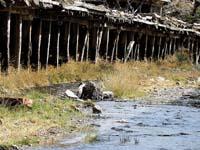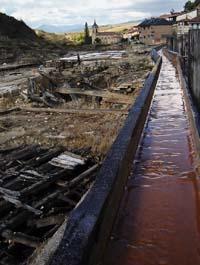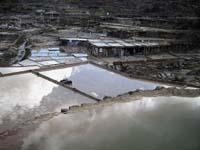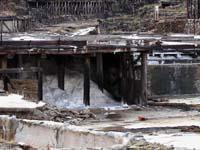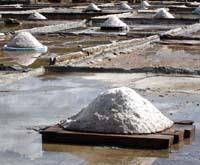Salinas de Añana, black to white
2006/02/01 Kortabarria Olabarria, Beñardo - Elhuyar Zientzia Iturria: Elhuyar aldizkaria
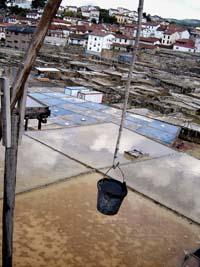
The diapiro is the main protagonist of the valley: a huge bag of salt hidden under the ground. When the rainwater enters the soil it crosses the diapiro and dissolves the underground salts. Consequently, springs with abundant salt emerge in the valley. This water has 210 grams of salt per liter, 50 times more than sea water. The sun, wind and salt make the water evaporate and salt.
Salt workers have been evaporating water in these ages for thousands of years. For many experts, Salinas de Añana can be the oldest municipality in Euskal Herria. The first written news about saline activity in Añana dates back to 822. At first it seems that the salt mines had private property, but eventually they became the property of the lords. Initial owners were forced to adapt to new forms of exploitation. In 1137, King Alfonso VII established the legal bases to structure the monopoly of salt, so that theoretically the product would be distributed better and better. XIII. In the eighteenth century the crown extracted a large amount of money from the salt trade, either because it directly exploited the salt mines, or because it donated them for rent.
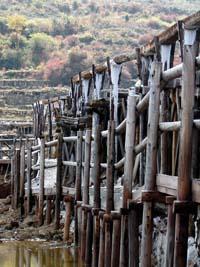
According to the remains found, it can be said that, at least from the Middle Ages, the salt collection eras were distributed throughout the valley, starting from the main spring. The eras were only placed on the lower slopes, in the areas of lower slope. Therefore, the ages were adjusted to the orography. Place or were not that conditioned the mountains and the direction of the water. Today we could talk about sustainable exploitation.
On the path of productivity
The crown drew a lot of money at the expense of the salt flats, but it wanted more; it knew that more salt could be drawn than it came out of the salt valley. Thus, in 1801, it launched a plan to dismantle and create new infrastructures. The goals of the reform were to get more and better salt. For this, most of the old ages were destroyed and new built. Only those who could match technical innovations survived. From the year 1814 each owner was returned the freedom to collect and sell salt to his taste to compete in the market. The salt trade became very important as it was used to keep food in good condition.
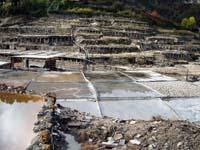
XX. At the beginning of the 20th century salt remained business, but not only in Salinas de Añana. Salt was also being produced in some coastal areas. These were new productions, with great technical advantages and, of course, with a lot of salt extracted and sold.
The Alaves began to make the most of the salt mines. Apart from the usual techniques of elaboration of the eras, they began to use cement. Cement was used, on the one hand, for the construction of infrastructures and, on the other, to increase production, since they placed the cement itself on the eras.
Production grew a lot, as the ages were easier to build and salt was collected more easily. Not only that. Until the cement began to be used, in Salinas de Añana a brown salt was obtained, of wood and clay color, and with white cement. But innovation was the beginning of the agony.
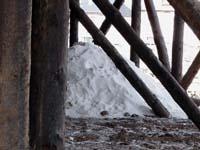
Salt affects almost all materials and cement deteriorated with harsh valley conditions and cracked. Sometimes the problem could be covered and solved, but many times, when the crack was too large, new layers of repair cement were placed on the eras.
By increasing the weight, the risk of falling the entire structure was added. Then it was mandatory to remove all cement layers. Removing the cement also removed the edges that were glued. Not recyclable. Numerous debris were also generated, but salty personnel did not take them out, as in addition to being difficult it was expensive. XX. From the mid-twentieth century --since the 1960s -, the salt business declined. The salt valley blackened. After 40 years of history, the salt mines became large cemeteries. Currently only 150 eras are exploited in Salinas de Añana. Only one worker works, the rest left him long ago.
However, the salt valley has not lost hope of being what it was again. The 'Salt Valley Integral Recovery Project' is in force after the decision that the exceptional beauty of the valley is something to be preserved. In collaboration with the institutions of the Autonomous Community of the Basque Country and Alava, a group of multidisciplinary experts addressed the recovery of the salt mines. Archaeological, architectural, socioeconomic, environmental, etc. studies have been carried out, all with the sole objective of recovering, individually, the 5,500 eras of the valley.
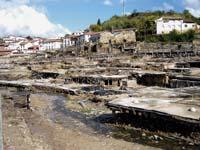
They have been working for five years and have recovered a small part. At the end of the work, within 20 years, many of these ages will resume salt production. Of course, from the economic point of view, salt production will not be profitable, since it will not compete in the market, but it will return life to the valley, to the living salty valley.
